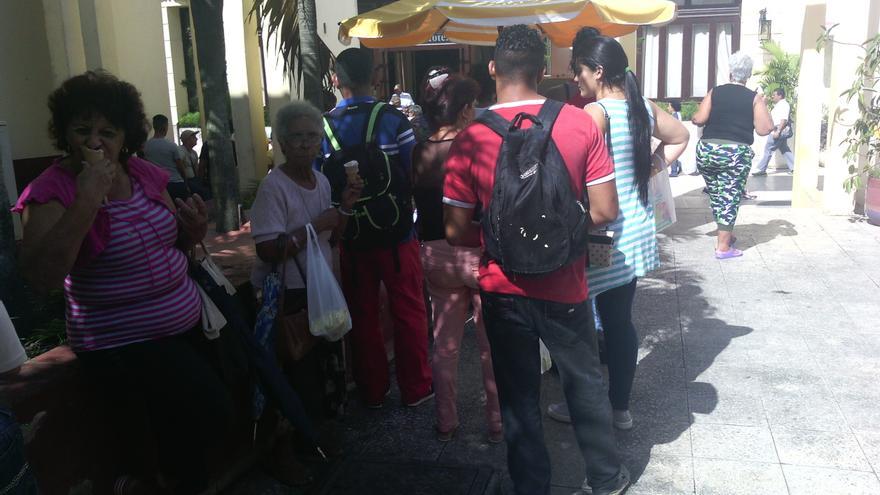
![]() Ricardo Fernández, Camagüey, 29 January 2018 — The ice cream parlor Copellia in the city of Camagüey has become an empty passageway between two main streets. Only the occasional passerby wanders into the empty building to access the Italian restaurant and three small shops on the floors above.
Ricardo Fernández, Camagüey, 29 January 2018 — The ice cream parlor Copellia in the city of Camagüey has become an empty passageway between two main streets. Only the occasional passerby wanders into the empty building to access the Italian restaurant and three small shops on the floors above.
At midday the employees take advantage of the calm hour in the previously crowded room, moving a table outside to enjoy a relaxed lunch without the pressure of waiting on customers.
The same scene repeats itself throughout the different ice cream parlors that were regularly supplied by the Helados Coppelia factory belonging to the Camagüey Dairy Products Company.
Two months after an ammonia leak in the factory, the industry has still not restarted and local consumers have been forced to depend on the private market to acquire the product. In the Cuban province with the strongest livestock tradition the ice cream parlors remain totally empty.
On the 29th of November last year an incident in the machinery room of the plant resulted in the release of this chemical substance which, according to authorities, does not present a health risk for either the workers or the residents of surrounding areas.
The directors of the industry have not given an expected date for the reactivation of production and no one knows when they will again supply the region’s state food service establishments. In the ice cream parlors and the TRDs (state run retail stores) the absence of ice cream is felt.
The incident came as a surprise to almost no one. The economic crisis, the scarcity of resources and the lack of technological renovation have caused a rampant deterioration in the province’s dairy industry, resulting in a decline in productive capacity.
Last March, the managing director of the company, Alexis Gil Perez, told the official press that only in the last few months have they succeeded in resuming the maintenance process but that still “not all of the accumulated problems have been solved.”
The state industry has the capacity to process up to 400,000 liters of milk a day, but the drought and problems of infrastructure have contributed to make the average production of the past year little more than 100,000 liters a day. The province of Camaguey accounts for 25% of Cuba’s total dairy production.
The Camaguey Provincial Dairy Products Company consists of 16 entities, including pasteurization plants, collection and cooling centers, mixing mills ,and cheese, ice cream and powdered milk factories.
The continued repairing of obsolete machinery has allowed production to be maintained for decades, but the technical difficulties continue to be numerous, especially concerning refrigeration and transportation to sites of distribution or sale.
Only three years have passed since the announcement of the assembly of a new evaporative condenser and ammonia system aiming to improve the refrigeration system of the industry Coppelia. The investment included the remodeling of the refrigerators and air conditioning of the sites of production.
With the paralysis of the plant following last November’s incident, the programmed maintenance has been moved up to this January and includes the installation of a new boiler and other equipment for the refrigeration system.

Local consumers hope that in a few weeks the factory will resume production, but the process drags on without any sign of an end date.
“In the beginning they brought ice cream in from Nuevitas, but the small factory barely manages to satisfy the demands of that municipality,” explained a customer of the main Coppelia ice cream parlor who prefers anonymity.
In the municipality of Subanicu in Camagüey, there is another small industry that produces ice cream for local consumption in a limited quantity. The plant, using Argentine technology, only possesses two flavor mixers and on good days achieves only 100 gallons in eight hours.
“What we are offering is mango soda. They have told us that the factory will be ready for production next month, but it is not certain,” a worker added, in the middle of the empty store.
The halting of the second largest ice cream factory in the country is not a source of bother for everyone. The indirect beneficiaries are workers who make ice cream independently.
Almost right across from Coppelia itself, on Antonio Maceo street, a large line forms in front of a small private establishment. “I’ve been here waiting for ten minutes because I’m craving ice cream,” says Yusleysi Gil. “It’s a little more expensive, but the flavor and presentation are better,” comparatively.
The reverse is happening in the TRDs, which receive the ice cream containers supplied to the factory in Camaguey. The typical refrigerators with glass covers that earlier displayed the varieties of Nestle ice cream, now just display their silver bottom.
The informal market has taken advantage of the success of this business and in neighborhoods nearby sellers offer pints of an artisanal ice cream that owe nothing to the state industry.
A privately owned, alternative ice cream maker can cost between 1000 and 3000 CUC (Cuban Pesos) in the classifieds.
Although the required investment is high, some local entrepreneurs are toying with the idea of joining the sale of ice cream in a city where the temperatures are rising and cold products are lacking.
Translated by Geoffrey Ballinger
___________________
The 14ymedio team is committed to serious journalism that reflects the reality of deep Cuba. Thank you for joining us on this long road. We invite you to continue supporting us, but this time by becoming a member of 14ymedio. Together we can continue to transform journalism in Cuba.
